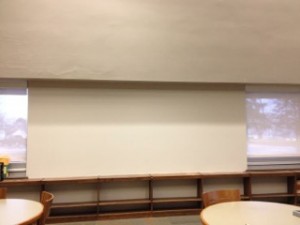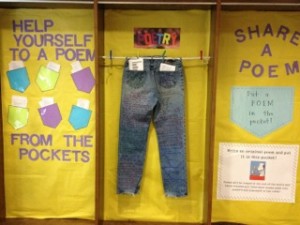2018 School Spending Survey Report
School Librarians Get No Love in Allentown School District
Once staffed with 13 elementary school librarians and four middle school librarians, today Allentown (PA) School District now has one district elementary school librarian serving all 15 elementary schools and two middle school librarians split among four middle schools.
 Hobbled by cuts to its school librarians over the past several years, Allentown (PA) School District (ASD) has seen attention to school libraries drop in priority, with the effect trickling to circulation as well as the amount of time students can spend in their libraries today. Once staffed with 13 elementary school librarians and four middle school librarians, today ASD has one district elementary school librarian serving all 15 elementary schools and two middle school librarians split among four middle schools, according to Donna Forsythe, an ASD middle school librarian at both Trexler and Francis D. Raub middle school. (Both ASD high schools still have a school librarian on staff.) Forsythe, a former ASD elementary school librarian, transferred to Trexler Middle School in the 2010–11 school year when ASD reduced elementary school positions from 13 to four. (They cut those four in the 2012–13 school year.) Forsythe is now predominantly a teacher, working with a class per grade every nine weeks, teaching them library skills—which closes the library for three periods a day. Paraprofessionals now staff the middle school library to check out books. The effect? A heavy drop in circulation. During the first four months of the current 2013–14 school year, circulation at Trexler Middle School was at 1,030 books—a 77 percent drop from the 4,664 books checked out during the first four months of the 2012–03 school year and a 84 percent drop from the 6,441 books checked out during the first four months of the 2011–12 school year, according figures provided by ASD staff.
Hobbled by cuts to its school librarians over the past several years, Allentown (PA) School District (ASD) has seen attention to school libraries drop in priority, with the effect trickling to circulation as well as the amount of time students can spend in their libraries today. Once staffed with 13 elementary school librarians and four middle school librarians, today ASD has one district elementary school librarian serving all 15 elementary schools and two middle school librarians split among four middle schools, according to Donna Forsythe, an ASD middle school librarian at both Trexler and Francis D. Raub middle school. (Both ASD high schools still have a school librarian on staff.) Forsythe, a former ASD elementary school librarian, transferred to Trexler Middle School in the 2010–11 school year when ASD reduced elementary school positions from 13 to four. (They cut those four in the 2012–13 school year.) Forsythe is now predominantly a teacher, working with a class per grade every nine weeks, teaching them library skills—which closes the library for three periods a day. Paraprofessionals now staff the middle school library to check out books. The effect? A heavy drop in circulation. During the first four months of the current 2013–14 school year, circulation at Trexler Middle School was at 1,030 books—a 77 percent drop from the 4,664 books checked out during the first four months of the 2012–03 school year and a 84 percent drop from the 6,441 books checked out during the first four months of the 2011–12 school year, according figures provided by ASD staff. “We have an 86 percent povery rate [at Trexler],” Forsythe. “These children don’t have libraries at home. They would come before and after school to use the computers in the library. I collaborated with teachers, taught them how to use tools and collaborate on research projects. Now they can’t get to the library, because half the day it's closed. They’re not using materials. There are no more books fairs. I used to have monthly literacy challenges for the whole school. These are all over.”Deb Tretter, president of the Allentown Education Association, believes that part of the reason school librarians are in this predicament is because of school board members' unwillingness to restore positions. Still, she has some hope that jobs may be restored when money itself is brought back to education funding. “Our board members are very limited in their understanding of what librarians do,” she says. “They’re not librarians like when we were in school, but that’s what [the board members] think, no matter how many times they were told [otherwise] by these articulate women. If we’re pushing STEM (science, technology, engineering and math), then [librarians] are the ’T’ in STEM.” Technology is not high in Shawn Kerbein’s job description right now. As a former ASD early childhood librarian and high school librarian, Kerbein is not the district elementary librarian for the district. In her first year in this new position, Kerbein is responsible for 15 elementary school libraries—most of which are supported by a half-time paraprofessional, she says. She does not have an office and spends days at different schools each week working on a variety of responsibilities from persuading principals to spend money on books for their school libraries to developing a storytelling curriculum.The library during more prosperous times at Trexler Middle School.

The bare library wall today at Trexler Middle School.
Kerbein said she’d like to find ways to be more integrated into the classroom, however she says when she approaches most of the elementary school principals they don’t pass her information along to teachers. She has been asked to some staff meetings to show the staff how to use databases or Destiny to find books in their own library. “I have met a lot of road blocks," she says. "I hear teachers tell students to Google. And I say, ‘No! Use these databases! We pay for them.'" Forsythe says she often hears administrators downplay the need for school libraries, noting that teachers have classroom libraries. But she says a classroom library can never really compete with the resources available in a school library collection, particularly around nonfiction books needed for meeting Common Core standards. “Typically teachers would coordinate with me for assessments,” she says. “And now, there’s no one there. An empty library is a sad thing.”RELATED
RECOMMENDED
CAREERS
The job outlook in 2030: Librarians will be in demand
CAREERS
The job outlook in 2030: Librarians will be in demand
ALREADY A SUBSCRIBER? LOG IN
We are currently offering this content for free. Sign up now to activate your personal profile, where you can save articles for future viewing







Add Comment :-
Comment Policy:
Comment should not be empty !!!
Michelle B.
As a point of clarity, those of us who are paraprofessionals remaining in the Allentown elementary schools are not half-time paras in terms of hours worked. We are employed full-time and we each spend half that time at one school and half at another. One para actually covers three elementary schools. We are hired and paid as "assistants" yet we are responsible for the daily operation of two libraries by ourselves. Some of us are being told that doesn't keep us busy enough so we are being pulled from the library to provide instructional interventions to special ed students or reading groups as well as other duties such as cafeteria monitoring. Some of us are not even given proper access to our respective libraries and are forced to provide library circulation on a cart rather than allowing students access to the full collection. Additionally, computers for student use have been removed from at least two libraries thus not allowing for catalog searches by students within the walls of the library. We see classes for 20 minutes every ten days. Twenty minutes in which to check in returned books, print out overdue notices, assist students in selecting materials, and check out those items...for classes sometimes as large as 35 students...that is when our schedule is not superseded by something else like standardized testing, benchmark testing, extracurricular activities or administrative meetings.Posted : Jun 20, 2014 07:44
Chad Kroll
This is very SAD! I am now a Middle School Librarian thanks to all the help and support I received when I was a middle school student in this same school district back in the 1970's! I feel so let down by the supervisors and administrators that allowed this to happen! It is a proven fact that the more a child is supported in the effort to read, the greater their vocabulary is, the better they do on achievement tests, and the higher they place on achievement tests. It is also a proven fact that this is achieved by utilizing full time, highly-qualified librarians to teach the students how best to choose what suits their needs at the time. there have even been studies done on this to prove the fact! And now we have administrators doing such a disservice to our own future. It is an utter disgrace!Posted : May 23, 2014 05:47